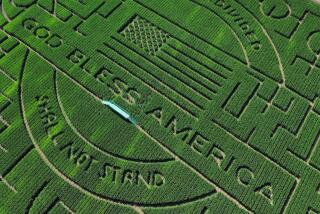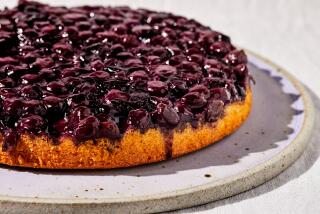Ear You Go: Sweet Corn Do’s and Don’ts
Question: What exactly is maize? Is it the same plant as corn? G.E., Laguna Niguel
Answer: Corn and maize refer to the same plant, zea mays, which is now one of the world’s three most important cereal crops.
Maize originated in the New World about 6000 BC to 5000 BC, probably in both Mexico and South America, where ancient Aztec, Maya and Inca civilizations depended on it.
By the time Columbus arrived in the New World, maize was the main cereal crop from Canada to Chile.
Maize mutates easily and is therefore an extremely variable species; Native Americans probably selected for varieties that did well in their area, resulting in many different varieties when Europeans first arrived.
Before the New World explorations, the word “corn” had been used in England to describe various cereal crops such as wheat, barley and oats. Maize was first called “Indian corn” and later just corn.
In the 1930s, U.S. growers began to take advantage of corn’s variability to produce high-yielding hybrids for different climatic zones. In 1935, 1% of the corn planted in the U.S. was hybrid; by 1970, virtually all U.S. corn was hybrid.
Use of hybrid cultivars, along with improved growing techniques, more than doubled production. Today’s corn is a domestic plant and wouldn’t survive in the wild, although early forms still grow in South America.
There are many different varieties of sweet corn available to the home gardener and new ones appear each year, varying in sweetness, in time to maturity, in disease and pest resistance, and in color.
Extra- or super-sweet types convert sugar into starch more slowly and therefore retain their sweetness longer after harvest.
Two sweet varieties include How Sweet It Is, which is a white sugar-enhanced corn and Early Xtra Sweet, a yellow super-sweet corn. They are All-America Selections and are resistant to most diseases. Golden Cross Bantam (yellow), Jubilee (yellow), Butter and Sugar (bicolor) and Silver Queen (white) have some disease resistance.
Baby corn is simply immature corn, and many varieties are suitable. Candystick, with its quarter-inch diameter cob at maturity, is a good one to try for this. Harvesting at the right time to get baby corn is tricky; you’ll have to experiment.
Sweet corn is a warm-weather crop that should be planted from March through July in Southern California. Plant seed 2 inches deep in rows 30 to 36 inches apart. Thin to 10 to 14 inches between plants.
Corn is wind-pollinated, so be sure to plant at least three to four rows, rather than one or two long ones. Without good pollination, full kernels will not develop.
At planting time, dig trenches on both sides of the seed row, 2 inches from seed in the furrow and an inch deeper than seed level and fertilize, using 3 pounds of 5-10-10 in each band per 100 feet of row.
When the corn is 8 inches high, feed a second time and again at 18 inches high.
Corn must be kept well-watered to produce a quality crop, particularly at the time the ears are maturing. Mulching will help.
Don’t remove suckers or side shoots that form; it is not necessary and may actually decrease yield.
To prevent corn ear worms, apply 20 drops of mineral oil to the silk inside the ear tip three to seven days after silk worms first appear to kill the worms before they enter the ear. Or just break off the wormy end of the ear and discard.
Corn plants may be attacked by various fungus and virus diseases; use resistant varieties where available. Rust fungus is more likely to occur if overhead sprinklers are used.
Incomplete kernel development can be caused by inadequate pollination, insufficient soil moisture or inadequate fertilizer. Earwigs may feed on the silks, preventing pollination; use traps and check daily for earwigs.
You can have a continuous corn harvest by planting early, mid- and late-season varieties, or by making successive plantings of the same variety every two weeks. Fall-maturing sweet is usually the highest quality, since cool nights during fall increase sugar content.
Sweet corn is ready for harvest about 17 to 24 days after the first silk strands appear; it takes less time in hot weather.
Harvest when husks are still green, silks are dry brown and kernels are full-sized to the tip of the ear. Use your thumbnail to puncture a kernel--if the liquid is clear, the corn is immature; if it’s milky, it’s ready; and if it’s dry, you’re too late.
Pick corn that must be stored for a day or two early in the morning and keep it cool. The best time to pick is just before eating. Sugar loss from standard varieties is rapid. Extra-sweet varieties hold their sweetness longer.
--Researched and written by University of California master gardener Mary Steele of Laguna Niguel.
*
Have a problem in your yard? University of California Cooperative Extension master gardeners are here to help. These trained and certified horticultural volunteers are dedicated to extending research-based, scientifically accurate information to the public about home horticulture and pest management. They are involved with a variety of outreach programs, including the UCCE Master Garden hotline, which provides answers to specific questions. You can reach the hotline at (714) 708-1646 or ucmastergardeners@yahoo.com. Calls and e-mail are checked daily and are generally returned within three days.
More to Read
Eat your way across L.A.
Get our weekly Tasting Notes newsletter for reviews, news and more.
You may occasionally receive promotional content from the Los Angeles Times.










